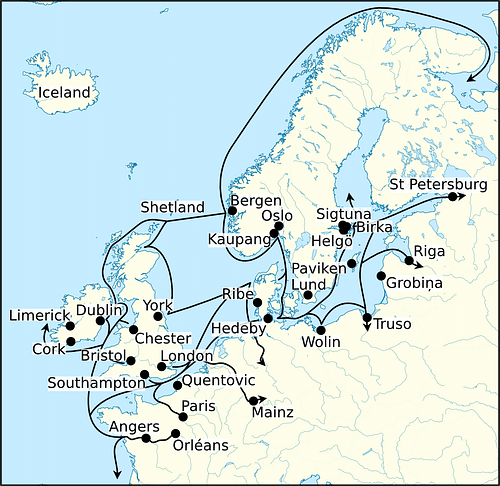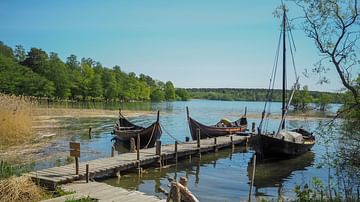
Hedeby (Old Norse: Heiðabýr; German: Haithabu) was an important stronghold in Viking Age Denmark from the 8th-11th centuries CE and, along with Birka in present-day Sweden, it was the most important Viking trading center in Europe. During this time it flourished under the control of Danish Vikings. Today, Hedeby is located near the city of Schleswig, Germany on the Jutland Peninsula, but it was Scandinavia's southernmost entrepôt in the Early Middle Ages. Due to its favorable position at the nexus of the Frankish Empire and Danish kingdom, as well as the the Schlei River which connects to the Baltic Sea, the town of Hedeby attained great wealth as a mercantile settlement with extensive trading ties to western Europe, Scandinavia, the Slavic and Byzantine east, as well as the Arab World. UNESCO recognized Hedeby's importance in medieval European history, declaring its archaeological site as well as the Danevirke defensive system which Hedeby's fortifications gradually became a part of as a World Heritage Site in 2018.
Founding & Early History
Hedeby's reconstructed Old Norse name, Heiðabýr, means “heath settlement". Situated at the southern end of the Jutland Peninsula, Hedeby is located just outside the modern city of Schleswig in Schleswig-Holstein, Germany, on the Schlei River. In the Early Middle Ages, the route along the Schlei River toward Hedeby was flanked by forest-covered moraines, which further protected and insulated the town from outside attack, making it quite attractive for settlement. Hedeby also lies at only 12 km from the Treene River that runs into the Eider River and ultimately the North Sea. This waterway gave Hedeby shipping access to the Baltic Sea, Scandinavia, as well as what is present-day Russia, while the latter allowed Hedeby's merchants to trade with polities in Western Europe.
Hedeby's genesis likely dates from the late 8th century CE, when jetties and workshops were constructed by Danish Vikings in the vicinity of what later grew into the town of Hedeby. The first written records historians have of Hedeby date to 804 CE from Frankish annals, and the Franks actually had a role to play in town's early history, too. By the 790s CE, the Franks were busy extending their presence northward and had already had successes in battle against the Frisians and the Saxons. The Obotrites, a Polabian Slavic tribe allied to the Franks, then defeated the Saxons at the Battle of Bornhöved in 798 CE. With Saxony vanquished and conquered in 804 CE, Charlemagne, King of the Franks (r. 768-814 CE), awarded his Obotrite allies former Saxon lands in what is now Schleswig-Holstein north of the Elbe River, which put the Franks and Obotrites right at Denmark's southern frontier along the Eider River.
Deeply disturbed at these events, King Gudfred of Denmark (r. 804-810 CE) restored and extended the so-called Danevirke fortification that cut across Jutland from Hedeby to the western coast of Denmark. It is probable that Gudfred recognized Hedeby's prime location as it lay so close to the ancient “Ox Road” that enabled Viking traders and soldiers to travel quickly up and down Jutland. Hedeby itself received a garrison of soldiers and a wall for its own protection, and Hedeby's streets were laid out in right angles, running parallel to a stream. A few years later, around 807 CE, Gudfred destroyed the Polabian Slavic settlement of Reric — perhaps the modern town of Rostock, Germany — killing Drozko, their leader, and resettling the town's merchants in Hedeby. Gudfred further enriched the town by virtue of his successful plundering of the Frisian coast just before his death in 810 CE.

Christianity arrived in Hedeby in the 820s CE after a member of the Danish royal family, Harald 'Klak' Halfdansson (c. 785-852 CE), visited the Frankish Empire and implored Emperor Louis the Pious (r. 813-840 CE) for assistance against his Viking rivals. Harald Klak converted to Christianity and returned to Hedeby with a Catholic priest who subsequently changed the course of Danish and Swedish history: Saint Ansgar (801-865 CE). King Horik I (r. 827-854 CE) of Denmark later allowed Saint Ansgar the right to build a Christian school and church in Hedeby, and Christianity gained some converts in Hedeby, although the vast majority of its inhabitants seemed to have remained pagan at least until the 11th century CE. Hedeby did receive a bishop in 948 CE, though, who worked under the aegis of the Archbishops of Bremen and Hamburg.
Hedeby's fortunes grew rapidly in the 9th and 10th centuries CE as trade with the Varangian Rus' (territories with a history of Viking presence in eastern Europe) and the Byzantine Empire increased. Swedes and Germans began to coveted its wealth as Hedeby began to mint its own coinage around c. 825 CE. At its height around 900 CE, Hedeby encompassed an area of around 24 hectares, had a population of approximately 1,500 people, and was surrounded by reinforced semicircular ramparts that led into a small fortress. The town was briefly captured by the Franks in 934 CE and then reoccupied by them in 974 CE; the Danes did not succeed in taking Hedeby back until 983 CE.

Trade & Daily Life in Hedeby
Hedeby is mentioned in several early medieval documents including Rimbert's Life of Saint Ansgar, Ohthere of Hålogaland's History Against the Pagans, Adam of Bremen's Gesta Hammaburgensis Ecclesiae Pontificum, and an Arab account written by Ibrahim bin Yaqub al-Turtushi (fl. 961-962 CE) in the middle of the 10th century CE. These records written by foreigners attest to a lively commercial town, populated by Danes, Frisians, Franks, Germans, Swedes, and Slavs, and archaeological excavation have confirmed Hedeby's multi-ethnic composition.
By the mid-9th century CE, as Hedeby began to grow quickly, the town's center shifted north towards a small brook, which would be transformed into a canal in the following century and protected with wooden planks. The jetties and docks in Hedeby's harbor appear to have been well-maintained. The typical dwelling at Hedeby was rectangular in size and shape with two or three rooms, and the town was densely populated like other early medieval settlements in Western Europe. Hedeby was, however, blessed with several natural freshwater springs, which local inhabitants used regularly.
Imports from long-distance trade allowed Hedeby's merchants to support an impressive array of craft industries — everything from ironworking with Swedish ore to bronze jewelry production took place at Hedeby. Soapstone and whetstone from Norway, ceramics and wine barrels from the Rhine River, pots from the Baltic Slavs, and even luxury textiles from Byzantium have been found by archaeologists at Hedeby. Of special note is Hedeby's manufacture of glass and amber beads as well as its textile production. Other trades practiced in Hedeby included amber working, shoemaking smithing, shipbuilding, and comb-making. Hedeby had its own slave market, which while meeting the disapproval of Christian missionaries was a constant feature of life and commerce in Viking Age Scandinavia.
Most people in Hedeby had livelihoods facilitated by trade or sailing. Theitmar of Merseburg, the Prince-Bishop of Merseburg (r. 1009-1018 CE), testifies in his chronicle to the brisk business of Hedeby's toll house around c. 1000 CE, and it may be possible that even more goods passed through here than through Hedeby's harbor. What is known is that traders are believed to have landed by ship near what is present-day Hollingstedt, Germany and then proceeded by wagon or portage to Hedeby. Historians and archaeologists can thus say that Hedeby was a major nexus of importation, exportation, and transit trade in Northern Europe.

Hedeby's Decline & Excavations
Hedeby declined as a major emporium in the late 10th century CE and early 11th century CE as a result of political, economic, and environmental shifts. The nearby city of Schleswig grew in importance as the Schlei River leading up to Hedeby's harbor became deeply silted-up with sand. In a protracted period of conflict between Norway and Denmark from 1048-1064 CE, Harald Hardrada of Norway (r. 1046-1066 CE) sacked Hedeby, setting the town and many of the ships in its harbor on fire. Snorri Sturluson (1179-1241 CE), the renowned Icelandic historian and poet, later made mention of this event in his Heimskringla. A final, devastating blow came in 1066 CE when Hedeby was sacked by Polabian Slavs. The residents of Hedeby then relocated across the Schlei River to Schleswig, which took over Hedeby's role as a mercantile center and conduit of international long-distance trade during the Middle Ages.
Archaeologists began excavating Hedeby in the early 20th century CE without the slightest idea as to where the original settlement had been located, the uncertainty caused in part due to rising waters and other ecological changes since the end of the Viking era. Archaeological efforts remain very much an ongoing effort at Hedeby as only a tiny percentage of the town has been thoroughly excavated. The Hedeby Viking Museum located near the site of Hedeby allows visitors to see first-hand some of the items archaeologists have found in recent years.







